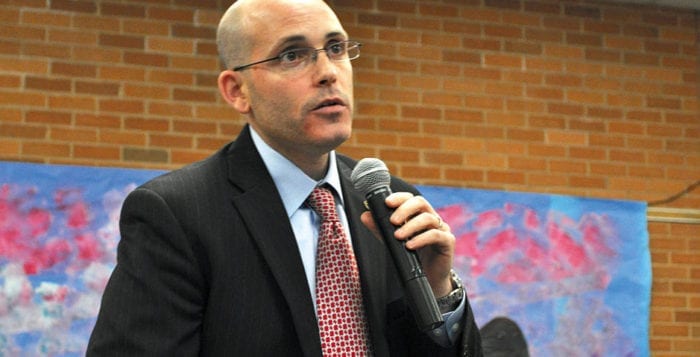Districts Wonder at New York’s Attempts to “Reimagine” Education
Earlier on in the still-ongoing pandemic, Gov. Andrew Cuomo (D) spoke of his intentions to remake the lagging parts of society. In early May, the governor announced a new committee to “reimagine” education in New York state. He tapped the Bill & Melinda Gates Foundation to serve as just one of several “experts and stakeholders” for the initiative and named numerous people throughout the state to serve on the committee.
But since that was announced May 8, little has been heard from the committee. Among its 19 members, two are from Long Island, including Martin Palermo, a chemistry teacher at William Floyd High School who was designated a Master Teacher by New York State in 2016, and Jackie Duodu-Burbridge, of Copiague, who was described as a parent in a state release, but also ran unsuccessfully on the Working Families Party ticket for the Suffolk County 15th District seat vacated by former Presiding Officer DuWayne Gregory (D-Amityville).
Palermo, who is currently working on a doctorate of chemical education at Stony Brook University, was unable to respond to requests for comment by press time about what kinds of discussions were going on in the committee. Duodu-Burbridge could not be reached for comment.
How involved is the Gates foundation? It’s hard to tell, but the organization did tell the Washington Post in a statement it is recommending experts and contributing its own insights into how technology can enhance learning.
For some school district officials, these calls instead brought forth shivers of memories from a little less than a decade ago, with the advent of standardized testing and Common Core where teachers’ evaluations depended on how well their students scored. The Gates foundation played a major part in crafting that initiative.
Some district officials worried it would be an attempt to make distance learning more standard going forward, even when the pandemic has died down. Cuomo since clarified the position that distance or online learning could “never replace in-person learning with a teacher,” yet school officials have remained skeptical for a number of reasons, with many still feeling the governor is emphasizing replacing in-person learning.
Ken Bossert, the superintendent of the Elwood school district, a former head of the Port Jefferson School District and past president of the Suffolk County School Superintendents Association, said he did not believe there is any need to reimagine education.
“A lot of educators heard that and winced a little bit because there is this false perception that what we were doing pre-pandemic wasn’t in the best interest of students,” he said. “I don’t think school districts need to be reimagined, I think they need to be revised — I think there is always room for improvement.”
Comsewogue school district has a long history of actively decrying Common Core and New York State’s attempts at standardized testing. Former Superintendent Joe Rella, who passed earlier this year, was a major opponent of the 2012 implementation of Common Core, writing a letter to New York State against its implementation in 2013. He was at the forefront of a rally hosted later that year which gathered support from thousands of residents.
The district later implemented problem-based learning initiatives as a response to those earlier state standardizations, and has been accredited by the Middle States Association of Colleges and Schools’ Commission on Elementary and Secondary Schools.
Comsewogue Superintendent Jennifer Quinn said the district is still waiting to see what comes out of the committee, especially since there has been little news since it was created.
“Each district has different populations, I don’t know if it will be one size fits all,” Quinn said. “I would like to see support for helping us with lower class sizes. All these social-distancing technologies, it’s very expensive. If we were going to come back to school, it’s very difficult to keep young kids apart.”
She added that the focus the committee has on online, technology-based learning and shared classrooms over the internet presents itself a huge, new problem. The pandemic has only exacerbated inequalities among some communities and districts on Long Island. Some districts have access to computers or Chromebook laptops they simply hand out to students. Others don’t have anything like that. Not to mention there is a wide disparity between households that have multiple devices that can access the internet and those that have few or none.
School districts are already internally trying to find ways to promote more technology in and out of the classroom, especially since the question of how schools will come back in the fall is still to be decided. Mount Sinai school board president, Robert Sweeney, has been on the board for the past nine years. He said the district has in the past dealt with issues over Common Core with creating its own agencies, books and instructions in-house when the state wasn’t offering much in the way of aid for teachers on the new material.
The district will be using a successful allocation under the Smart Schools Bond Act to bolster their internal networks, potentially increasing the school’s online options.
“How much technology can we get into the hands of our students, what can we do with classroom-based technology, what can we do with technology to our students at home?” Sweeney said. “Let’s take it out of these difficult times and put it into the new normal.”
Bossert was recently named to the New York State Education Department’s Regional Reopening Schools Task Force. He said a subcommittee of that group is specifically looking at tackling that lack of access to technology.
But in the end, he said such a reimagining committee should not be handled by the governor’s office.
“The governor should empower the state Education Department to work with the 700 school districts of the state,” Bossert said. “I’m not sure it should be a function of the governor’s office.”







